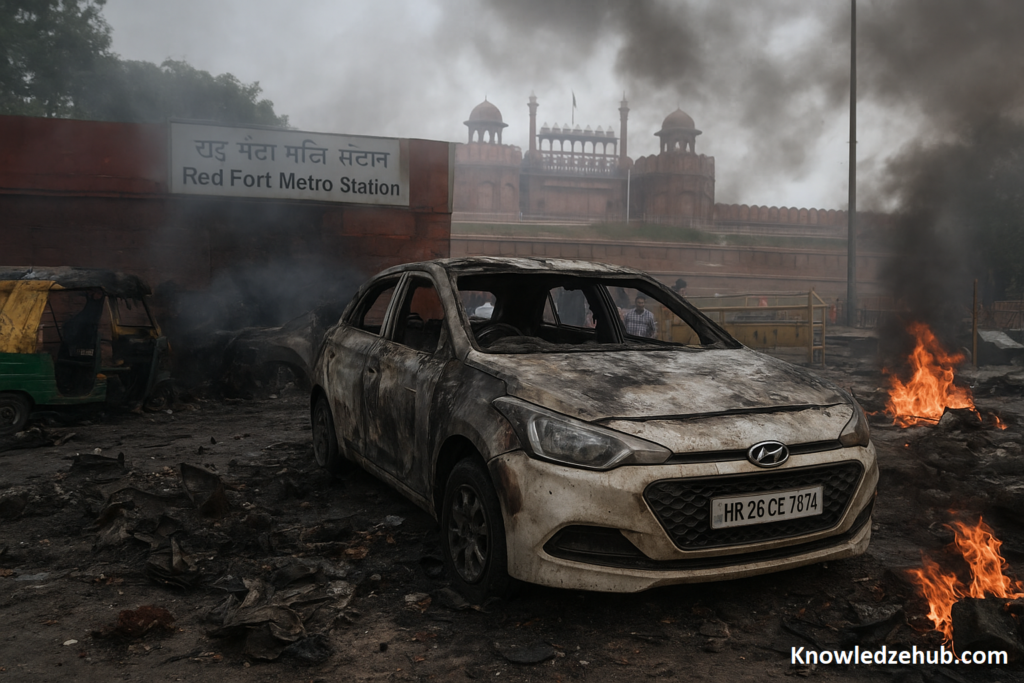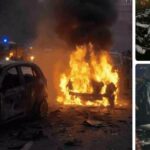The shocking car explosion near Red Fort Metro Station in Delhi on 10 November 2025 continues to dominate headlines. The blast, which killed at least 10 people and injured several others, has now been officially classified as a terror-related incident under the Unlawful Activities (Prevention) Act (UAPA).
Here’s everything uncovered so far — from arrests and forensic updates to security alerts across the country.
The Incident Recap
At around 6:52 PM on Sunday, a white Hyundai i20 car suddenly exploded near the Red Fort Metro Station, one of Delhi’s busiest tourist and traffic zones. The explosion set nearby vehicles ablaze and shattered windows of shops and houses within a 200-meter radius.
Eyewitnesses reported a loud noise followed by flames and thick smoke. Emergency services and police arrived within minutes, cordoning off the area and diverting traffic.
By late evening, the blast site had turned into a high-security zone, with forensic teams, fire department, and anti-terror units examining debris for traces of explosives.
How Investigators Identified the Car
According to Delhi Police, the vehicle involved in the explosion was a Hyundai i20 bearing registration number HR 26 CE 7674, registered in Gurugram, Haryana. CCTV footage revealed that the car had entered the Red Fort parking area around 3:19 PM, remained there for a few hours, and later moved onto Netaji Subhash Marg, where it exploded.
Preliminary checks found the number plate intact, helping investigators trace the ownership chain. The vehicle reportedly changed hands multiple times over the past few months, complicating the probe.
Officials suspect the car was used deliberately to carry an explosive device, rather than a case of accidental fire or mechanical failure.
Legal Action: UAPA and Explosives Act Invoked
The case has been registered under the Unlawful Activities (Prevention) Act (UAPA) and the Explosives Act. This move indicates that authorities are treating the blast as a suspected terrorist attack.
The National Investigation Agency (NIA) and Delhi Police Special Cell are jointly leading the investigation. The decision to invoke UAPA came after initial forensic indicators suggested the use of high-intensity explosives, not ordinary fuel combustion.
Also Read : https://knowledzehub.com/blast-near-red-fort-metro-station-delhi/
Arrests and Detentions So Far
Police sources confirm that at least two individuals have been detained in connection with the vehicle’s chain of sale. The original registered owner, identified as Salman from Gurugram, reportedly sold the car earlier this year.
Another suspect, believed to have purchased the car recently, is under questioning for inconsistencies in his statements.
Investigators are also examining whether the suspects had links to any terror modules or organized criminal networks operating out of Delhi, Haryana, or western Uttar Pradesh.
According to intelligence inputs, one of the suspects may have past associations with a Faridabad-based group that had been under surveillance for suspicious activities.
Forensic Investigation: What the Labs Found
Teams from the Central Forensic Science Laboratory (CFSL) and National Bomb Data Centre (NBDC) have been collecting residue samples from the blast site. Early results suggest traces of RDX or a similar high-grade explosive, often used in coordinated attacks.
A senior investigator said,
“The nature of the blast and intensity indicate the presence of an improvised explosive device (IED). The triggering mechanism is still being analyzed — it could be remote-controlled or time-based.”
The blast caused a deep crater near the vehicle, pointing to an undercarriage detonation rather than a fuel tank explosion. Experts believe this setup was designed to cause maximum impact in a crowded area.
CCTV Footage and Movement Trail
Delhi Police analyzed over 200 CCTV clips from the area, reconstructing the vehicle’s route from Faridabad to Red Fort. Footage shows two people in the car entering the parking area around 3 PM, but only one person exiting the vehicle later.
Officials are now trying to confirm whether the second person left on foot or perished in the explosion. The driver’s charred remains are yet to be conclusively identified through DNA profiling.
Investigators have also traced the vehicle’s earlier movement near Ashram Chowk and Daryaganj, indicating a deliberate route toward the high-traffic Red Fort area.
Security Measures and Nationwide Alerts
Following the explosion, Delhi Police, Metro Rail authorities, and Home Ministry declared a high alert across major cities including Mumbai, Chandigarh, Jaipur, and Lucknow.
Security checks at metro stations, bus terminals, and airports have intensified. In Delhi, the Lal Qila Metro Station remains temporarily closed for public safety, and two nearby roads have been diverted.
Explosive detection squads are conducting regular sweeps around India Gate, Parliament, and Connaught Place to ensure no secondary threats remain.
The Home Ministry has directed all states to strengthen surveillance near religious sites, markets, and public transport hubs ahead of the festive season.
Political Response and National Concern
Prime Minister Narendra Modi, who was on a visit to Bhutan at the time, described the blast as part of a “larger conspiracy.” Home Minister Amit Shah chaired a high-level emergency meeting in Delhi, directing agencies to coordinate intelligence inputs and submit an interim report within 48 hours.
Chief Minister Arvind Kejriwal visited the site the following day and announced an ex-gratia compensation for victims’ families. He also called for tighter checks on parking near national monuments.
What Is Still Unclear
Despite major progress in the investigation, several crucial questions remain unanswered:
- What was the exact motive behind the explosion?
- Who placed the explosive device inside the car?
- Was there an organized terror group behind it, or a lone-wolf act?
- Why was the car parked for hours before being driven into traffic?
- Was the driver aware of the explosive inside the vehicle?
Officials are awaiting forensic and call record analysis to answer these questions. Until the DNA and chemical tests are complete, investigators are cautious about drawing conclusions.
Why This Case Is Significant
This is the most serious explosion in Delhi since the 2011 High Court blast, and it occurred just meters away from one of India’s most important national symbols — the Red Fort.
The use of a moving vehicle near a public metro station suggests a possible attempt to undermine urban security protocols and spread fear.
The swift application of UAPA, deployment of NIA, and high-level coordination across state police forces underline the seriousness of the threat.
What Happens Next
Authorities are now focusing on five critical aspects of the investigation:
- Forensic Confirmation: Determine the type of explosive and triggering mechanism.
- Ownership Chain: Trace every person who bought or used the car in recent months.
- Call & Location Data: Map the suspects’ digital footprints and last known movements.
- Terror Links: Verify intelligence suggesting connections to sleeper cells or modules.
- Security Protocols: Review vehicle parking and surveillance systems around Delhi’s monuments.
Officials expect a detailed NIA briefing once initial forensic results are finalized, likely within the next few days.



